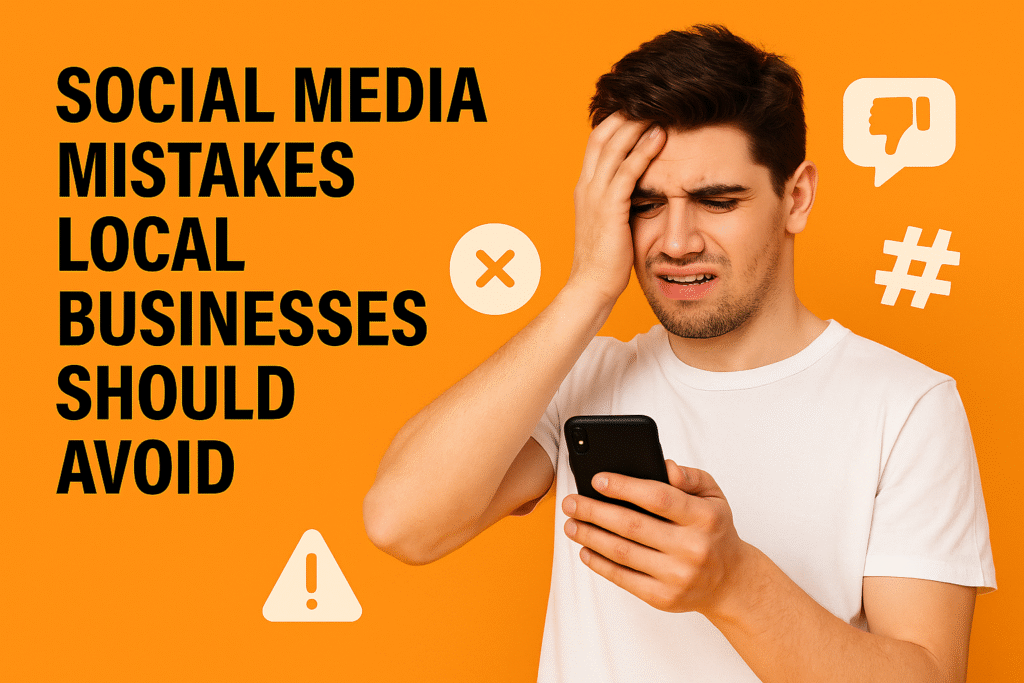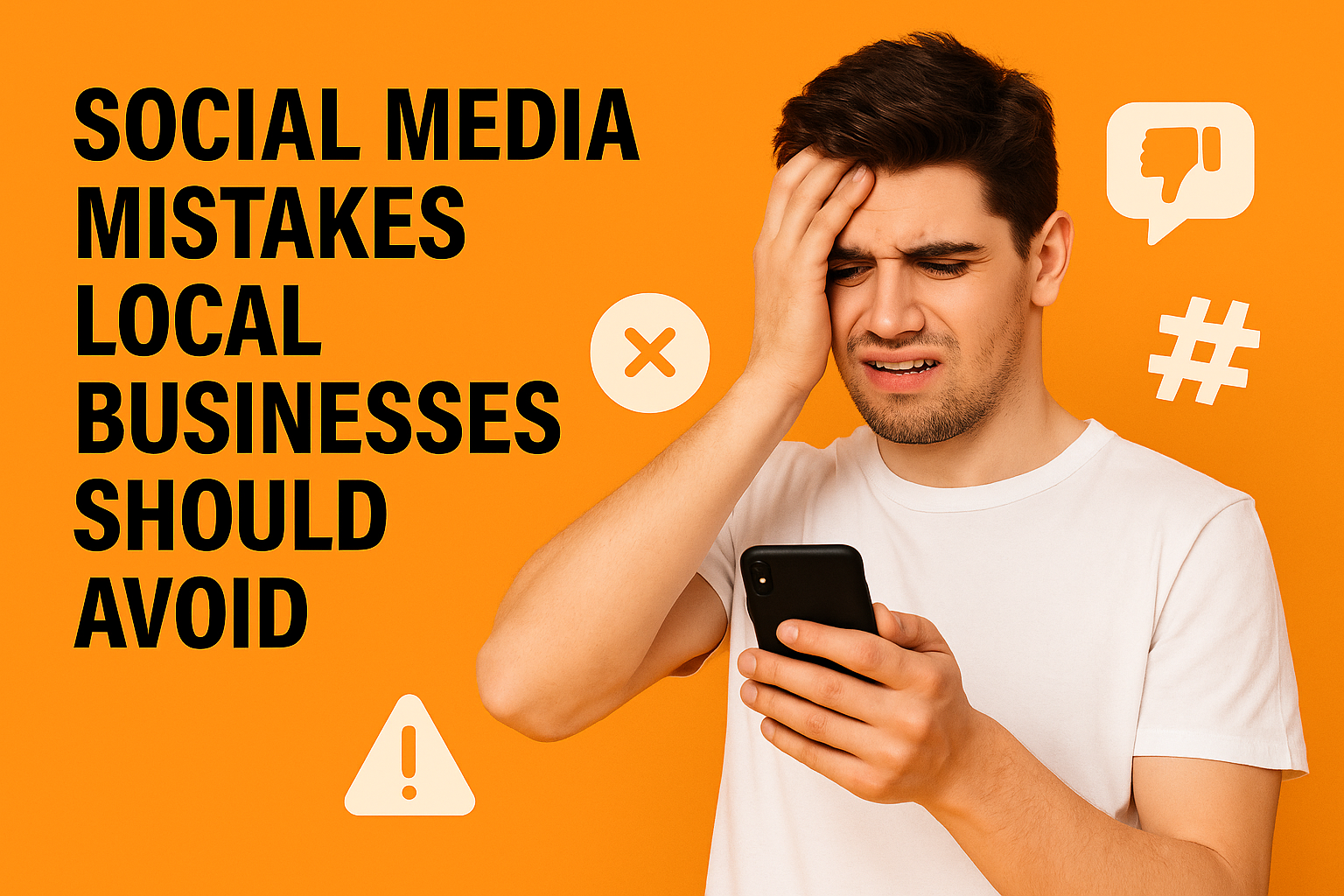Social Media Mistakes Local Businesses Should Avoid


Social media has become an essential marketing tool for local businesses across the UK.
From bustling cafés in Manchester to independent shops in Brighton, a strong social presence can attract new customers, build loyalty, and boost your bottom line.
But with so many platforms, trends, and tactics, it’s easy to make mistakes that can hold your brand back—or worse, damage your reputation.
At Socially Spotted, we’ve seen even the most passionate local businesses stumble into common social media pitfalls.
The good news? These mistakes are easy to fix once you know what to look for.
Here’s your comprehensive guide to the social media mistakes local businesses should avoid—and what to do instead to keep your brand thriving online.
Choosing the Wrong Platforms
Not every social network is right for every business.
One of the biggest mistakes is spreading yourself too thin or focusing on platforms your customers don’t use.
For example, if your audience is mostly families and professionals, TikTok may not be your best bet—Facebook and Instagram might be more effective.
On the other hand, if you’re targeting young adults, Instagram and TikTok could be goldmines.
How to avoid it:
- Do some research to find out where your target customers spend their time.
- Focus your efforts on one or two platforms where you can be consistent and effective.
- Don’t feel pressured to be everywhere—quality beats quantity every time.
Ignoring Engagement and Community
Social media isn’t just a megaphone for your business; it’s a two-way street.
One of the most damaging mistakes is ignoring comments, messages, or reviews.
When you don’t respond, your business can seem unapproachable or uncaring, which can turn off potential customers.
How to avoid it:
- Respond promptly to comments and messages, even if it’s just a quick thank you.
- Like, comment on, and share posts from your followers and other local businesses.
- Ask questions, run polls, and invite feedback to start real conversations.
Example:
A local bakery in Leeds replies to every comment on their posts, whether it’s a compliment or a complaint.
This builds trust and encourages more people to engage.
Posting Only Self-Promotional Content
If your feed is just a stream of sales pitches, people will tune out.
Social media is about building relationships, not just selling.
Constant self-promotion can actually drive followers away.
How to avoid it:
- Follow the 80/20 rule: 80% of your content should be helpful, entertaining, or community-focused; only 20% should be direct promotion.
- Share local news, behind-the-scenes stories, customer testimonials, and useful tips.
- Celebrate your team, your community, and your customers—not just your products.
Inconsistent Posting or Abandoning Your Profiles
A deserted or rarely updated social profile can make your business look unprofessional or unreliable.
On the flip side, posting in bursts and then disappearing confuses your audience and hurts your visibility.
How to avoid it:
- Create a simple content calendar and stick to a regular posting schedule (even if it’s just 2–3 times a week).
- Use scheduling tools like Buffer or Hootsuite to plan posts in advance.
- If you’re short on time, focus on fewer platforms and keep your updates consistent.
Not Setting Clear Goals or Tracking Results
Posting without a plan is like driving without a map.
If you don’t set goals or track your analytics, you won’t know what’s working—or what’s a waste of time.
How to avoid it:
- Decide what you want from social media: more website visits, local awareness, or direct sales?
- Set measurable goals (like “gain 100 new followers this month” or “get 10 new enquiries”).
- Use built-in analytics (like Facebook Insights or Instagram Analytics) to track your progress and refine your strategy.
Neglecting Video Content
Short-form video is now the most engaging content on social media.
If you’re not using video, you’re missing out on reach and engagement—especially as people watch more video than ever before.
How to avoid it:
- Start simple: film a quick product demo, a staff introduction, or a behind-the-scenes tour.
- Use Instagram Reels, Facebook Stories, or TikTok for short, authentic videos.
- Don’t worry about perfection—authenticity wins on social media.
Example:
A florist in Bristol shares short “how-to” videos on flower arranging, which are shared widely and bring in new customers.
Not Tailoring Content to Each Platform
Every social network has its own style and audience.
Posting the same message everywhere can look lazy or out of place—and may even backfire if your content isn’t suited to the platform’s format or culture.
How to avoid it:
- Adjust your tone, format, and visuals to fit each platform.
- Use hashtags on Instagram, share local news on Facebook, and keep TikTok videos fun and fast-paced.
- Always double-check that your content makes sense for the platform and your audience.
Ignoring Analytics and Insights
If you never look at your analytics, you’re missing a huge opportunity to learn what your audience likes and what drives results.
How to avoid it:
- Check your analytics weekly or monthly to see which posts perform best.
- Look for patterns: What time of day gets the most engagement? What topics get the most shares?
- Use this data to refine your strategy and focus on what works.
Not Including Calls to Action
Every post should have a purpose.
If you forget to include a call to action (CTA), you’re missing a chance to guide your audience—whether that’s to comment, visit your website, book an appointment, or share your post.
How to avoid it:
- Add clear CTAs like “Tell us your favourite,” “Book now,” or “Share with a friend.”
- Make it easy for followers to take the next step.
Relying Only on Organic Reach
Organic reach (unpaid posts) has dropped on most platforms.
If you’re not using paid ads or boosting posts, your updates may not reach enough people—especially when launching a new product or event.
How to avoid it:
- Set aside a small budget for targeted ads or boosted posts, especially for important updates.
- Use the powerful targeting tools on Facebook and Instagram to reach local customers by location, age, or interests.
Example:
A local gym in Birmingham boosts posts about new classes to reach people living nearby, resulting in a surge of trial bookings.
Not Optimising Your Profile
A half-completed or outdated profile can turn away potential customers.
Your social media pages are often the first place people check for information about your business.
How to avoid it:
- Make sure your profiles include your logo, up-to-date contact details, opening hours, and a clear description of what you do.
- Use consistent branding and high-quality images.
- Add your location and a link to your website or booking page.
Failing to Be Transparent and Authentic
Trying to be something you’re not, hiding negative feedback, or being unclear about promotions can damage trust.
Social media users value honesty and authenticity.
How to avoid it:
- Be upfront about what you offer and any terms of your promotions.
- Own up to mistakes and respond to negative feedback with empathy and solutions—not defensiveness.
- Show the real people and stories behind your business.
Ignoring Customer-Generated Content
Your customers are your best marketers.
Not encouraging or sharing user-generated content (UGC)—like photos, reviews, or stories—means missing out on powerful, authentic promotion.
How to avoid it:
- Invite customers to tag your business or use your hashtag when they share their experience.
- Repost or share their content (with permission) to show appreciation and build community.
- Run contests or campaigns that encourage UGC.
Example:
A restaurant in Newcastle runs a monthly contest for the best customer photo, with winners featured on their Instagram.
Overposting or Posting at the Wrong Times
Posting too much can overwhelm followers, while posting at odd hours can mean your updates get buried.
How to avoid it:
- Stick to a consistent, manageable schedule.
- Use analytics to find the best times to post for your audience.
- Focus on quality, not just quantity.
Mishandling Mistakes or Negative Feedback
Everyone makes mistakes—but how you handle them matters.
Ignoring, deleting, or responding defensively to negative comments can escalate issues and damage your reputation.
How to avoid it:
- Respond quickly and professionally to complaints or criticism.
- Apologise if needed, offer solutions, and show you care about customer satisfaction.
- Learn from feedback and use it to improve your business and your social media approach.
FAQs:
What is the biggest social media mistake local businesses make?
The most common mistake is ignoring engagement—failing to reply to comments, messages, or reviews—which makes your business seem unapproachable and can cost you loyal customers.
How often should a local business post on social media?
Aim for consistency—2 to 4 times a week is a good starting point.
The key is to post regularly without overwhelming your audience.
Is it bad to post only about your products or services?
Yes. Constant self-promotion can turn off your audience.
Balance sales posts with helpful, entertaining, or community-focused content.
Should I use paid ads as a local business?
Yes. Relying only on organic reach limits your visibility. Even a small budget for targeted ads or boosted posts can help you reach more local customers.
What if I get a negative comment or review?
Respond quickly, professionally, and with empathy.
Address the issue, offer solutions, and show you value customer feedback.
Conclusion
Social media can be a game-changer for local businesses—but only if you avoid the common pitfalls that hold so many brands back.
By focusing on the right platforms, engaging with your community, posting consistently, and staying authentic, you’ll build trust, attract new customers, and grow your reputation online.
At Socially Spotted, we’re here to help you make the most of every post—so learn from these mistakes, put your best foot forward, and watch your local business thrive on social media.
